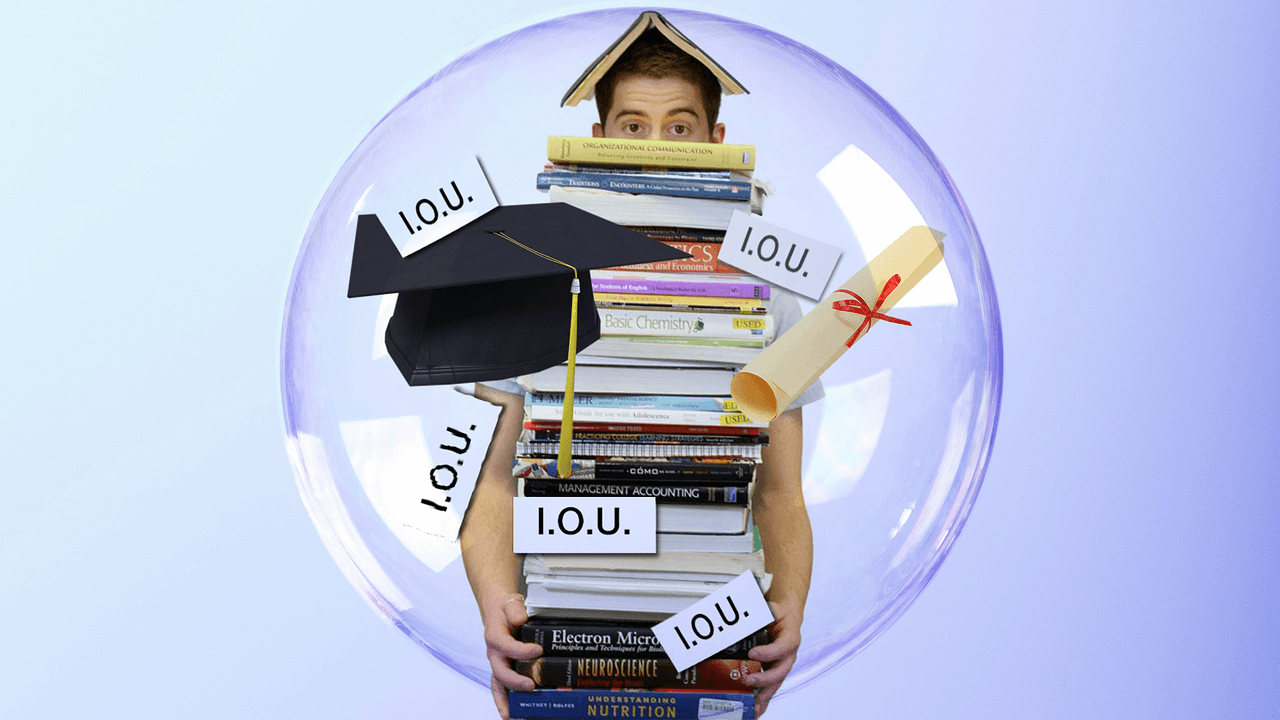Student-centric advice and objective recommendations
Higher education has never been more confusing or expensive. Our goal is to help you navigate the very big decisions related to higher ed with objective information and expert advice. Each piece of content on the site is original, based on extensive research, and reviewed by multiple editors, including a subject matter expert. This ensures that all of our content is up-to-date, useful, accurate, and thorough.
Our reviews and recommendations are based on extensive research, testing, and feedback. We may receive commission from links on our website, but that doesn’t affect our editors’ opinions. Our marketing partners don’t review, approve or endorse our editorial content. It’s accurate to the best of our knowledge when posted. You can find a complete list of our partners here.
Guide to Student Loan Forgiveness Programs
 By
Kayla Korzekwinski
By
Kayla Korzekwinski 
Kayla Korzekwinski is a Scholarships360 content writer. She earned her BA from the University of North Carolina at Chapel Hill, where she studied Advertising/PR, Rhetorical Communication, and Anthropology. Kayla has worked on communications for non-profits and student organizations. She loves to write and come up with new ways to express ideas.
Full BioLearn about our editorial policies

Maria Geiger is Director of Content at Scholarships360. She is a former online educational technology instructor and adjunct writing instructor. In addition to education reform, Maria’s interests include viewpoint diversity, blended/flipped learning, digital communication, and integrating media/web tools into the curriculum to better facilitate student engagement. Maria earned both a B.A. and an M.A. in English Literature from Monmouth University, an M. Ed. in Education from Monmouth University, and a Virtual Online Teaching Certificate (VOLT) from the University of Pennsylvania.
Full BioLearn about our editorial policies

With an average federal debt (not including private loans!) of $37,090 each, it is no wonder that student borrowers are looking for relief. Student loan forgiveness is possible through a number of programs. Many of them have specific eligibility requirements, so it’s important to know which ones you may be eligible for.
There are three forms of relief from paying student loans: discharge, forgiveness, and cancellation. Each of these terms basically means the same thing. The main difference is found in why or how your loans are relieved.
Keep on reading to learn about student loan forgiveness, including which federal student loans will qualify, as well as specific forgiveness and discharge programs.
What is Student Loan Forgiveness?
If you no longer have to make student loan payments because of your job or because of your participation in a repayment program, you’ll receive forgiveness or cancellation.
Only federal student loans are eligible for forgiveness through government programs.
What types of federal student loans qualify for forgiveness?
There are three types of federal loans that can be eligible for forgiveness: Direct Loans, Federal Perkins Loans, and Federal Family Education Loans.
As a refresher, here’s a quick overview of each type of federal student loan.
Direct Loans
Direct loans are offered through the William D. Ford Federal Direct Loan Program. Undergraduate students, their parents, or students in graduate or professional school may apply for these subsidized or unsubsidized loans.
Federal Perkins Loans
As of 2018, the government has stopped offering Perkins Loans. Perkins Loans were for undergraduate or graduate students who showed exceptional financial need.
Federal Family Education Loans
Like Perkins Loans, Federal Family Education Loans (FFEL) have not been disbursed since 2010. The FFEL Program offered direct loans to students through private lenders that were subsidized and guaranteed by the U.S. Federal Government.
Student loan forgiveness programs
Below you can learn more about the top student loan forgiveness and cancellation programs. Remember, these programs will only impact federal student loans and not private student loans.
Income-Driven Repayment Plans
There are four types of federal income-driven repayment plans: Pay As You Earn (PAYE), Revised Pay As You Earn (REPAYE), Income-Based Repayment (IBR), and Income-Contingent Repayment (ICR). These plans allow you to cap your monthly loan payments at a percentage of your income. Each one of the income-driven repayment plans offers forgiveness on your remaining loan balance at the end of the payment period, which can be 20 or 25 years.
Public Service Loan Forgiveness (PSLF)
This loan forgiveness program is available for federal direct loans. To be eligible for PSLF, you must work full-time for the government or a not-for-profit organization. Volunteering full-time with AmeriCorps or Peace Corps also counts as qualifying employment. Applicants must also be enrolled in an income-driven repayment program and make 120 qualifying loan payments.
The PSLF Tool will help you determine if you’re eligible or on the right track for PSLF. You can submit an application for PSLF through the U.S. Department of Education.
Teacher Student Loan Forgiveness
Highly-qualified teachers may be eligible for forgiveness of federal direct loans after five consecutive years of employment at a low-income school. Eligible math, science, and special education teachers receive up to $17,500. Teachers who do not teach one of those three subjects will receive up to $5,000.
To apply for this loan forgiveness, you must complete a teacher loan forgiveness application at the end of your fifth year of eligible employment.
Learn more: Everything you need to know about the TEACH Grant
Federal Perkins Loan Cancelation
Eligible teachers will receive cancellation on a portion of their Perkins Loans for each full academic year they are employed full-time. The cancellation also includes the interest accrued during that time. They must teach special education, math, science, foreign language, bilingual education, or another subject that has a designated teacher shortage at a low-income school.
Other professions that may qualify for Perkins Loan cancellation are early childhood education provider, firefighter, law enforcement officer, librarian, military soldier or officer, nurse or medical technician, public defender, and speech pathologist. Volunteer service with AmeriCorps or PeaceCorps might also be eligible. People employed at a family services agency or a tribal college or university can also be eligible.
Military Student Loan Forgiveness
The branches of the U.S. military offer their own student loan repayment programs for active duty members or veterans. The amounts and eligibility vary, but most require a certain number of years of service. For example, the Army offers up to $65,000 of forgiveness on federal loans for active duty service members who enlist for three years. Research your military branch and its requirements to find out if you could qualify for loan forgiveness through the military.
Additionally, veterans who were permanently and totally disabled in action can automatically receive discharge of their loans.
Student loan forgiveness for healthcare professionals
Doctors can participate in the National Health Service Corps Loan Repayment Program. This program provides up to $75,000 in loan forgiveness after a two-year service commitment to provide primary care for communities in need. A $5,000 award enhancement is available for those who are proficient in Spanish.
Nurses can apply for the Nurse Corps Loan Repayment Program. This program will pay 85% of outstanding nursing education loans. This is also a two-year program in an area that is lacking health professionals.
Other healthcare loan forgiveness programs include the Indian Health Service Loan Repayment Program, the Faculty Loan Repayment Program, and NIH Loan Repayment Programs.
Dentists and pharmacists can also be eligible for student loan forgiveness and repayment programs. Most of these programs vary based on the state they’re located in.
Student loan forgiveness for lawyers
Lawyers can also choose from a number of loan repayment programs. For example, The Department of Justice offers an Attorney Student Loan Repayment Program. Attorneys must have at least $10,000 of remaining debt and must commit to three years of service.
Law schools and a handful of states also provide loan repayment assistance to recent law school graduates who may be unable to work in the public sector because of their debt.
Student loan forgiveness for veterinarians
Veterinarians can receive loan repayment through the U.S. Department of Agriculture’s Veterinary Medicine Loan Repayment Program. The Department of Agriculture will pay up to $25,000 each year for three years to veterinarians who agree to serve in underserved areas.
What is Student Loan Discharge?
Student loan discharge is another way that students can relive themselves of their student loan burden. Below are a few situations that may entitle you to student loan discharge.
Closed School Student Loan Discharge
Your student loans may be eligible for discharge if your school closes while you were enrolled or shortly after you withdrew. This loan discharge happens automatically three years after your school closes, but you can apply to receive loan discharge sooner. Contact your loan servicer to discuss how.
Borrower Defense to Repayment Discharge
This loan discharge option is available for direct loans. If you took student loans out but your school defrauded or misled you, your loans might be eligible for discharge. To receive Borrower Defense to Repayment Discharge, you must submit an application to the Department of Education.
Total and Permanent Disability Discharge
If you become totally and permanently disabled physically or mentally and can no longer work, your federal loans can be discharged. To be eligible, you must submit an application to the Department of Education. You must also provide proof of your disability from either the VA, the Social Security Administration, or a physician.
Discharge Due to Death
Lastly, federal loans are eligible for discharge if the borrower passes away. To be eligible for discharge due to death, proof of death must be submitted to the loan servicer.
Other student loan resources
If you’re interested in student loan forgiveness, you may also want to read up on consolidation and refinancing. Also, our guide for the best student loan repayment plans will help you decide on a plan based on your financial situation, career, and goals.
It is possible to find relief from student loan debt through forgiveness. In most cases, you will have to work for it. But, overall, any forgiveness can be worth it!
Frequently asked questions about student loan forgiveness
Who is not eligible for student loan forgiveness?
Are student loans being garnished in 2024?





